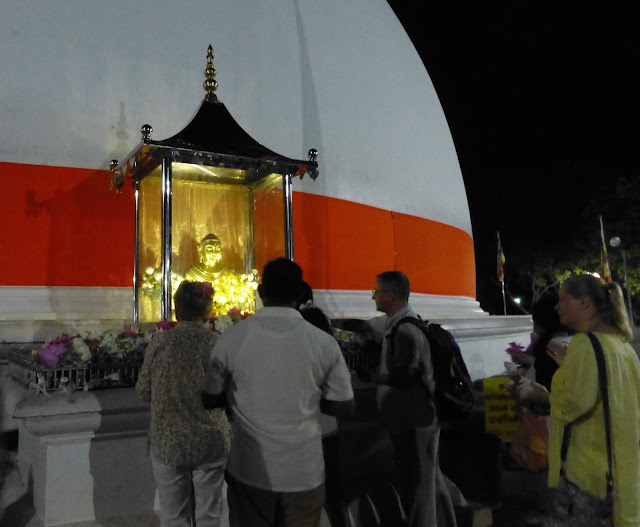 |
| Kataragama gate, Magha puja, photo by mary M Payne |
Tonight we are off to our first religious ceremony in Sri Lanka. We are off to Kataragama.
"Kataragama (Sinhalese: කතරගම (katharagama), Tamil: கதிர்காமம் (katirkāmam)) is a pilgrimage town sacred to Buddhist, Hindu and indigenous Vedda people of Sri Lanka.
The town boasts Ruhunu Maha Kataragama devalaya, a shrine dedicated to Skanda-Murukan also known as Kataragamadevio. And although Kataragama was a small village in
medieval times, it is now a fast-developing town surrounded by
jungle here in the southeast.
It also houses the ancient Kiri Vehera stupa which is, along with the bodhi tree there, a place of worship for Buddhists.
In spite of the differences of caste and belief, many Sri Lankans show reverence to God Kataragama.
They honor him as a powerful deity and beg divine guidance "to overcome their personal problems or for success in business enterprises, etc. They believe that God Kataragama exists and is vested with extraordinary power to assist those who appeal to him with faith and devotion in times of distress or calamity." Wikipedia
We arrived for the ceremony on the night of the full moon, the Magha puja . According to our Sri Lankan guide, Waruna, who is himself a Buddhist, the spiritual aims of the day are to refrain from committing any kind of sins; to do only good and to purify one's mind.
"The Bo tree at Kataragama ( also called Bodhi tree)" is one of the eight saplings (Ashta Phala Ruhu Bodhi) of Sri Maha Bodhiya in Anuradapura, Sri Lanka. This tree was planted in the 3rd century BC." Wikipedia
To those of us who had never attended a puja ceremony, the evening was quite stupefying. First all of one's shoes are removed and kept at a special booth before entering the sacred enclosure. We then proceeded barefoot into a large courtyard to wait for to give our offering.
The Hindu ceremony consisted of every kind of fanfare: dignitaries entering under canopies; red carpets rolled out and taken up again; incense; horns; lights; etc. Followers were all dressed in white and waited patiently for the ritual to begin. It seemed a long wait and the trays grew heavy. After the worshipers entered the temple and the ceremony progressed we were then able to pass through to see the inside.
The Hindu religious service itself seemed to consist of blessings, prayers and after, the cutting of the fruits that had been offered by one of the priests.
Apparently God Kataragama and the other deities only have to smell the fruit in order to receive the homage and then in a practical gesture, the fruit may be distributed and eaten by those participating.
After receiving a woven bracelet blessing from a hindu priest we proceeded to the huge Bo tree behind the temple and the offering of flowers we had bought to be delivered at both the tree and the stupa.
The white "foster's freeze" domes found throughout the world are the temples of the Buddhists. Here was a large and an old one, freshly painted. These structures are known as stupas. According to Waruna, the interior is rarely visited by followers but is used by priests and dignitaries for meditation. It usually contains a relic of the Buddha as well.
https://en.wikipedia.org/wiki/Stupa
Here are a few pictures of the evening:
 |
| Fruit stand with trays to rent for Offerings, Kataragama, Photo by Mary M Payne |
 |
| Fruit vendor prepares a covering for our offering. Kataragama, photo by Mary M Payne |
 |
| Pauline holds our carefully assembled offering, Kataragama, photo by Mary M Payne |
 |
| Stray dogs are a significant presence in Sri Lanka. photo by Mary m Payne |
 |
| Fruit trays ready for puja, Kataragama, photo by Mary M Payne |
 |
| Sri Lankan child before her parent's stand. photo by mary m payne |
 |
| Flower offerings for the Buddhist ceremony are placed beneath the Bo Tree. , Kataragama photo by Mary M Payne |
 |
| Buddhist Stupa, Kataragama, photo by Mary M Payne |
 |
| We give flower offerings at the Kataragama Stupa, |
 |
| Stray dog, Sri Lanka, photo by Mary M Payne |
 |
| Smashed coconuts from Hindu Ritual at Kataragama, photo by Mary M Payne |
On the way out of the courtyard I snapped this picture. Another ritual which is now universally received in Asia originated with the Hindus. It has to do with smashing a coconut and this was the place designated for such a practice at Kataragama.
"Smashing a coconut is symbolic of annihilating the ego and humbling
oneself before God. Whenever a work of magnitude is undertaken it is
natural for the persons involved to feel a sense of pride at what they
are setting out to achieve or what they have achieved. This ritual
indicates that the actual “doer” is God and humans are merely
instruments in his hands. Coconuts are also broken before the deities in
temples during normal worship. Again, the philosophy is the same –
complete submission to God." Quote from Rkgoel's Blog from Wordpress)
After returning our tray, we returned to our cocoon, the bus. The sight of the many stray dogs everywhere, the odor of incense, the strange events, going barefoot through the sand....it was all a bit surreal.
I realized that we had just witnessed a ritual of worship without the requisite background of beliefs. That left us all with a special kind of ignorance. Certainly we knew more than when we had come.
That is the way of the traveler. One gets a taste, a first glimpse, but not more. Still, I think we were all a little wiser as we boarded our bus back to our last night at Kirinda Beach.

ReplyDeleteMary, your photos astound me...such colors...especially of the fruits and pastries!
ronni
Mary , I am enjoying the whole journey.
ReplyDeleteCynthia
Truly interesting....
ReplyDeleteJohn P.